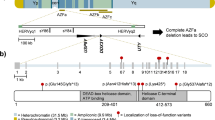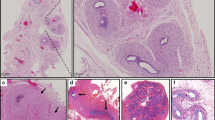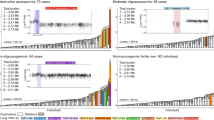Abstract
46,XY gonadal dysgenesis (GD) is a disorder of sex development due to incomplete gonadal differentiation into testes, resulting in female to ambiguous external genitalia. Duplications at the Xp21.2 locus involving the NR0B1 (DAX1) gene have previously been associated with 46,XY GD. More recently, a complex structural variant not directly involving NR0B1 has been reported in 46,XY GD illustrating that the mechanism of how copy number variants (CNVs) at Xp21.2 may cause 46,XY gonadal dysgenesis is not yet fully understood. Here, we report on three families in which a duplication involving the NR0B1 gene was detected in the context of prenatal screening. This is the first report of duplications involving NR0B1 in three phenotypically normal males in two families. Fertility problems were present in one adult male carrier. The data reported here from an unbiased screening population broaden the phenotype associated with CNVs involving NR0B1, and this may aid clinicians in counseling and decision making in the prenatal context.
This is a preview of subscription content, access via your institution
Access options
Subscribe to this journal
Receive 12 print issues and online access
$259.00 per year
only $21.58 per issue
Buy this article
- Purchase on Springer Link
- Instant access to full article PDF
Prices may be subject to local taxes which are calculated during checkout


Similar content being viewed by others
Data availability
All data generated or analyzed during this study are included in this published article.
References
Berkovitz GD, Fechner PY, Zacur HW, Rock JA, Snyder HM, Migeon CJ, et al. Clinical and pathologic spectrum of 46,XY gonadal dysgenesis: its relevance to the understanding of sex differentiation. Medicine. 1991;70:375–83.
Domenice S, Machado AZ, Ferreira FM, Ferraz-de-Souza B, Lerario AM, Lin L, et al. Wide spectrum of NR5A1-related phenotypes in 46,XY and 46,XX individuals. Birth Defects Res C Embryo Today. 2016;108:309–20.
Barbaro M, Oscarson M, Schoumans J, Staaf J, Ivarsson SA, Wedell A. Isolated 46,XY gonadal dysgenesis in two sisters caused by a Xp21.2 interstitial duplication containing the DAX1 gene. J Clin Endocrinol Metab. 2007;92:3305–13.
Barbaro M, Cicognani A, Balsamo A, Löfgren A, Baldazzi L, Wedell A, et al. Gene dosage imbalances in patients with 46,XY gonadal DSD detected by an in-house-designed synthetic probe set for multiplex ligation-dependent probe amplification analysis. Clin Genet. 2008;73:453–64.
Ledig S, Hiort O, Scherer G, Hoffmann M, Wolff G, Morlot S, et al. Array-CGH analysis in patients with syndromic and non-syndromic XY gonadal dysgenesis: evaluation of array CGH as diagnostic tool and search for new candidate loci. Hum Reprod. 2010;25:2637–46.
White S, Ohnesorg T, Notini A, Roeszler K, Hewitt J, Daggag H, et al. Copy number variation in patients with disorders of sex development due to 46,XY gonadal dysgenesis. PLoS One. 2011;6:e17793.
Barbaro M, Cook J, Lagerstedt-Robinson K, Wedell A. Multigeneration inheritance through fertile XX carriers of an NR0B1 (DAX1) locus duplication in a kindred of females with isolated XY gonadal dysgenesis. Int J Endocrinol. 2012;2012:504904.
Dong Y, Yi Y, Yao H, Yang Z, Hu H, Liu J, et al. Targeted next-generation sequencing identification of mutations in patients with disorders of sex development. BMC Med Genet. 2016;17:23.
García-Acero M, Molina M, Moreno O, Ramirez A, Forero C, Céspedes C, et al. Gene dosage of DAX-1, determining in sexual differentiation: duplication of DAX-1 in two sisters with gonadal dysgenesis. Mol Biol Rep. 2019;46:2971–8.
Smyk M, Berg JS, Pursley A, Curtis FK, Fernandez BA, Bien-Willner GA, et al. Male-to-female sex reversal associated with an approximately 250 kb deletion upstream of NR0B1 (DAX1). Hum Genet. 2007;122:63–70.
Meinel JA, Yumiceba V, Künstner A, Schultz K, Kruse N, Kaiser FJ, et al. Disruption of the topologically associated domain at Xp21.2 is related to 46,XY gonadal dysgenesis. J Med Genet. 2023;60:469–76.
Francese-Santos AP, Meinel JA, Piveta CSC, Andrade JGR, Barros BA, Fabbri-Scallet H, et al. A novel look at dosage-sensitive sex locus Xp21.2 in a case of 46,XY partial gonadal dysgenesis without NR0B1 duplication. Int J Mol Sci. 2022;24:494.
Bayindir B, Dehaspe L, Brison N, Brady P, Ardui S, Kammoun M, et al. Noninvasive prenatal testing using a novel analysis pipeline to screen for all autosomal fetal aneuploidies improves pregnancy management. Eur J Hum Genet. 2015;23:1286–93.
Wang Y, Song F, Zhang B, Zhang L, Xu J, Kuang D, et al. The 3D Genome Browser: a web-based browser for visualizing 3D genome organization and long-range chromatin interactions. Genome Biol. 2018;19:151.
Acknowledgements
We thank the patients and their families who participated in this study.
Author information
Authors and Affiliations
Contributions
Conceptualization: NV, GVB, KD, KVDB, NB. Visualization: NV. Writing original manuscript: NV. Supervision: GVB, KD, KVDB, NB
Corresponding author
Ethics declarations
Competing interests
The authors declare no competing interests.
Ethical approval
This study is approved by the Ethics Committee Research of University Hospitals Leuven (S67531). In compliance with the Declaration of Helsinki, written informed consent was obtained from all patients who participated in this study.
Additional information
Publisher’s note Springer Nature remains neutral with regard to jurisdictional claims in published maps and institutional affiliations.
Rights and permissions
Springer Nature or its licensor (e.g. a society or other partner) holds exclusive rights to this article under a publishing agreement with the author(s) or other rightsholder(s); author self-archiving of the accepted manuscript version of this article is solely governed by the terms of such publishing agreement and applicable law.
About this article
Cite this article
Veyt, N., Van Buggenhout, G., Devriendt, K. et al. Expanding the phenotype of copy number variations involving NR0B1 (DAX1). Eur J Hum Genet 32, 421–425 (2024). https://doi.org/10.1038/s41431-023-01522-6
Received:
Revised:
Accepted:
Published:
Issue Date:
DOI: https://doi.org/10.1038/s41431-023-01522-6
This article is cited by
-
Artificial intelligence â the next generation of sequencing?
European Journal of Human Genetics (2024)



